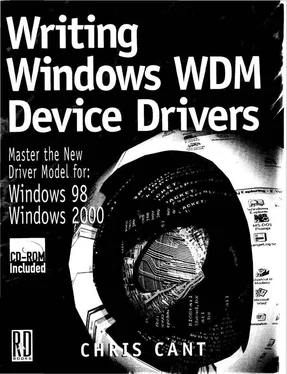Chris Cant - Writing Windows WDM Device Drivers
Здесь есть возможность читать онлайн «Chris Cant - Writing Windows WDM Device Drivers» весь текст электронной книги совершенно бесплатно (целиком полную версию без сокращений). В некоторых случаях можно слушать аудио, скачать через торрент в формате fb2 и присутствует краткое содержание. Город: Lawrence, Kansas 66046, ISBN: , Издательство: R & D Books, Жанр: Программирование, на английском языке. Описание произведения, (предисловие) а так же отзывы посетителей доступны на портале библиотеки ЛибКат.
- Название:Writing Windows WDM Device Drivers
- Автор:
- Издательство:R & D Books
- Жанр:
- Год:неизвестен
- Город:Lawrence, Kansas 66046
- ISBN:0-87930-565-7
- Рейтинг книги:5 / 5. Голосов: 1
-
Избранное:Добавить в избранное
- Отзывы:
-
Ваша оценка:
- 100
- 1
- 2
- 3
- 4
- 5
Writing Windows WDM Device Drivers: краткое содержание, описание и аннотация
Предлагаем к чтению аннотацию, описание, краткое содержание или предисловие (зависит от того, что написал сам автор книги «Writing Windows WDM Device Drivers»). Если вы не нашли необходимую информацию о книге — напишите в комментариях, мы постараемся отыскать её.
Writing Windows WDM Device Drivers — читать онлайн бесплатно полную книгу (весь текст) целиком
Ниже представлен текст книги, разбитый по страницам. Система сохранения места последней прочитанной страницы, позволяет с удобством читать онлайн бесплатно книгу «Writing Windows WDM Device Drivers», без необходимости каждый раз заново искать на чём Вы остановились. Поставьте закладку, и сможете в любой момент перейти на страницу, на которой закончили чтение.
Интервал:
Закладка:
The IEEE 1394 bus driver enumerates and controls the IEEE 1394 (Firewire) high speed bus. This bus driver uses port drivers to talk to the IEEE 1394 control electronics. IEEE 1394 client drivers issue IEEE 1394 Request Blocks (IRBs) to control their device.
The Universal Serial Bus (USB) bus driver enumerates and controls the lower-speed USB bus. Host controller drivers are provided as standard to talk to the two main types of USB host controller. USB client drivers use various IOCTLs to talk to their device via the USB class driver. The most important IOCTL lets clients issue USB Request Blocks (URBs) to control their device.
The SCSIand CDROM/DVDdrivers are used to access hard disks, floppies, CDs, and DVDs. As usual, a variety of port and miniport drivers are used to talk to hardware. For example, requests to a CD-ROM on the IEEE 1394 bus would be routed to the IEEE 1394 bus driver.
The Human Input Device (HID) class driver provides an abstract view of input devices. The actual input hardware can be connected in different ways that are shielded by HID minidrivers. Quite a few HID devices are on the USB bus, so a HID minidriver for the USB bus is provided as standard. HID clients can either be user mode applications or, if need be, kernel mode drivers. Standard parsing routines are available to make sense of HID input and output reports.
Finally, the Still Image Architecture (STI) is not a driver at all, but a means of obtaining scanner and still image camera using minidrivers. STI currently supports SCSI, serial, parallel, and USB devices.
With all these different types of drivers lurking around, it is worth while having a look at one real example to see how it all fits together. You do not need to know the detailed terminology yet.
Figure 2.6 shows the hardware and software components that are involved in the handling of a HID keyboard attached to the USB bus. On power up, the PCI bus driver finds the USB controller and so loads the USB class drivers. In this case, the USB OpenHCI host controller driver is used to talk directly to the hardware.
The USB host controller electronics detects when the keyboard is plugged in. The USB root hub bus driver is informed. It tells the Plug and Play Manager that a new device has arrived. The keyboard Hardware ID is used to find the correct installation INF file. In this case, the HID class driver and its USB minidriver are loaded, along with the standard HID keyboard client driver.
The HID keyboard driver uses Read IRPs to request keyboard data. The HID class driver asks the USB minidriver to retrieve any HID input reports. The minidriver uses an Internal IOCTL to submit URBs to the USB class drivers to read data. The USB class drivers talk directly to USB host controller electronics to get any available data. The electronics finally generates the correct signals on the USB bus. These are interpreted by the USB keyboard and it returns any keypress information. The results percolate up the device stack and will eventually reach a Win32 program in message form.
Figure 2.6 also shows that a user mode HID client can access the HID keyboard using standard Win32 ReadFile and WriteFile requests.
Figure 2.6 HID USB keyboard example
Driver Choices
You need to evaluate all the information in this chapter so you can decide at the outset what sort of driver to write for your device. There are various factors and choices that will influence your decisions.
The simplest approach is to buy an off-the-shelf driver that handles your device directly. Such drivers might not be available. However, there are various commercial general purpose drivers available, as described earlier. These can be tailored with scripts or the like to interact with many simple devices. The PHDIo and WDMIo drivers described later in this book can be used to talk to devices with I/O ports and a simple interrupt handling requirement.
If at all possible, you should use one of the standard bus or class drivers, as these will usually have implemented a large amount of the functionality that you need. Indeed, for many types of devices, using the system driver is the only way to access it. The only drawback is that you will have to study the detailed documentation in the DDK for the class of device that you are using. However, I can assure you that it is a darn sight easier to write a USB client than having to write a huge monolithic USB driver from scratch.
If using a standard bus or class driver, you will usually be writing a driver that supports Plug and Play. Your driver should usually, therefore, run in W98 and W2000.
Most of the standard bus and class drivers are not available in NT 4 and earlier. In fact, any driver that supports NT 4 or earlier must be an NT style driver. In some cases, it still makes sense to write an NT style driver for W98 and W2000.
Plug and Play drivers are always layered drivers, as they always form a layer in a device stack. However, NT style drivers can also layer themselves over other drivers. Drivers in a device stack will receive IRPs sent to any of the devices in the stack.
It is quite possible for a driver to use a device stack but not include itself in the stack. For example, drivers that use Plug and Play Notification are usually NT style drivers. Whenever a suitable device is inserted, such a driver will want to use the device. It can layer itself into the device stack, and so receive all IRPs sent to the device stack. Alternatively, it can just store a pointer to the device object at the top of the device stack. This way, it can issue requests to the device without receiving unwanted requests from above. The HID client driver described in Chapter 23 shows how to use this technique.
It will soon become evident that in some cases, you need to write a low-level driver to talk to your device. The question now is whether yours is a general purpose device or not. If it is has just one specialized use, then writing a monolithic driver to handle all device requests may well be the simplest solution.
However if you want your device to interface into Windows smoothly, you will usually [ need to write a suitable minidriver, miniclass, or miniport driver. The DDK and supporting documentation must be used to determine the exact requirements for these types of drivers. In extreme cases, you may decide to write a whole new class driver, but I would not recommend it.
As mentioned earlier, your driver should support Power Management, Windows Management Instrumentation (WMI), and NT event reporting. It is best to build in Power Management support from the beginning. It is possible to bolt on the other two aspects later. However, if you wish to collect performance information for your WMI reporting, it is best to design this in from the start.
WDM Rationale
I am willing to hazard a few comments about the Windows Driver Model (WDM) design to give you my ideas of how well it achieves its goals.
It is the role of device drivers to interface the operating system to hardware devices. They must eventually support the information flows that users and their applications require. In Windows, the specification of Win32, with multiple processes and threads, has implications for device drivers. And a user requirement for fast processing of video and audio data means that device drivers now have to do much more than just receive and send data.
Device drivers have to process a wide variety of data. The simplest example of input data is a keyboard keypress. Keypresses do not happen very often, but they do need to get to an application with visual feedback provided quickly. The next important type of data is the blocks of data that make up file systems. Speed and data integrity are the crucial issues here. Finally, for isochronous data, being able to keep up with the data is the most important factor, even if it means dropping some samples.
Читать дальшеИнтервал:
Закладка:
Похожие книги на «Writing Windows WDM Device Drivers»
Представляем Вашему вниманию похожие книги на «Writing Windows WDM Device Drivers» списком для выбора. Мы отобрали схожую по названию и смыслу литературу в надежде предоставить читателям больше вариантов отыскать новые, интересные, ещё непрочитанные произведения.
Обсуждение, отзывы о книге «Writing Windows WDM Device Drivers» и просто собственные мнения читателей. Оставьте ваши комментарии, напишите, что Вы думаете о произведении, его смысле или главных героях. Укажите что конкретно понравилось, а что нет, и почему Вы так считаете.






